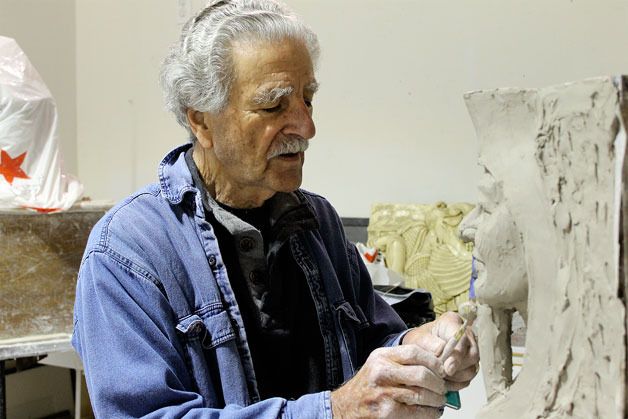As soon as Frank Rose stepped on Whidbey Island in 1985, he’s been all about the arts. A quick walk around Langley can show the fruits of his labor, too.
A longtime advocate of arts on South Whidbey, Rose is still active as ever despite being 86. His list of accomplishments in the arts are many and include being a founder of the Whidbey Island Center for the Arts. He is also credited with keeping the Whidbey Island Arts Council afloat and strong over the years, where he’s served as a board member, president and his current position as chairman. He’s also an active sculpture and painter, who spends a good deal of his time at the Freeland Arts Studio.
Rose’s current work includes the implementation of the Langley Arts Commission’s six-year, $800,000 master plan which hopes to renovate Seawall Park as well as install a number of art pieces around the city, further flourishing the already abundant presence the arts have in town. He played a large role in the Clyde Alley Archway recently installed on Third Street
“I know very few people who are as dedicated as he is to broadening and enlivening the island arts scene,” said Don Wodjenski, president of the Whidbey Island Arts Council. “He has a surprising well of energy to keep putting into the program. I don’t know of anybody who comes close to his degree of participation and advocacy on the island.”
Rose firmly believes that the impact of the arts in Langley, including WICA and other arts, have played a significant role on the economic development of the town.
“When you look at it, WICA and the performing arts are a big chunk of our economy,” Rose said. “There’s all kind of stuff going on here with the arts.”
“That’s another reason I liked this island, because it had a hub for arts.”
Though he’s firmly planted his feet on Whidbey Island, Rose is originally from the East Coast. He was born roughly 25 miles north of Time Square in New York. When he was a kid, he visited museums in the city and found a calling toward the arts.
That was all put on hold, however, when he joined the Navy in January of 1948. It offered attractive bonuses, such as traveling the world. Rose re-enlisted in the Navy when the Korean War began, and served as a missile offer on a surface-to-air missile cruiser in the Gulf of Tonkin for two and a half years. After the war’s end, he spent the next 27 years moving up the military ladder, eventually retiring as a lieutenant commander.
“You take pride in the fact that you served your country,” Rose said.
Though his career was in the military, his love for the arts never faded. While on shore duty early in his career, Rose found the time to attend life drawing classes at places like Ventura College. It was there he developed a knack for drawing the human body and features of a face.
“Part of my skill and creativity comes from life drawing,” Rose said.
After the Navy, Rose worked for the government for four years coordinating overhauls of naval carriers in shipyards. It was after this when he found his way to Whidbey Island. After his parents passing, Rose and his sister split 10 acres of land near Foxspit Road where Rose settled down in 1985. It wasn’t long after when he joined the arts council, where he was part of the grassroots movement to create WICA. Rose said that his friends and South Whidbey residents, Ken and Doll Hassrick, were also influential in establishing a performing arts venue in Langley, known today as WICA. They developed a friendship over the years and were art associates while sharing Hassrick studio space and life modeling costs. In 2002, Hassrick was stricken with a rare neurological disease that caused him to lose full use of his arms and legs. Rose spent many hours with Hassrick reviewing drawings for reproduction, planning art sales for Hassrick’s remaining work. One of Hassrick’s last wishes was to make his work benefit island artists, so with the help of Hassrick’s son Matt, the majority of his work was donated to the Whidbey Island Arts Council. Rose showed over 40 of Hassrick’s paintings, drawings and prints at the Freeland Arts Studio on July 14, and proceeds directly supported the council’s artist in residence program.
Rose said that their efforts over the years to increase the visibility of arts were also made easy by the fact that Langley has always been an “artsy” community.
“There’s a long history of artists living in Langley — there were colonies of artists,” Rose said.
His work with the council led to major events coming to South Whidbey, such as the Seattle Symphony.
Kay Parsons, vice president of the Whidbey Island Arts Council, said, along with being an exceptional pool player, Rose is also adept at fundraising, as well as communicating to people the value of the money that put into a certain event or cause.
“He’s just a very nice man. He tries hard,” Parsons said. “No matter what happens, he gets back up and does it again, and it takes a certain mindset to do that.”



